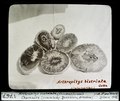History
The first remains of Arthropitys were discovered in the Leukersdorf Formation, Germany during the early 16th century and were described by Georgius Agricola (1494–1555) in 1546.
In the mid-18th century, gemstone prospector David Frenzel (1691–1772) found numerous examples of this wood in the hills in and around Chemnitz. [7]
One of Frenzel's 1751 finds is one of the few petrified wood specimens still possessing its roots. Later a collector, the Hilbersdorf contractor Güldner, bequeathed some of the petrified logs to King Albert Museum in Chemnitz. The first director of the Museum, Johann Traugott Sterzel, took over the investigation of the findings. The Sterzeleanum in the museum (the petrified forest display) is dedicated to him. [8]
The genus Arthropitys was named and described by Frenzel (1751) and the type species A. bistriata was named by Cotta (1864). [9] The type locality for A. bistrata and A. sp. is the Chemnitz petrified forest.
From 4 April 2008, to Fall 2011, an excavation in Hilbersdorf was held to find and research more trunks. Their researchers discovered, amongst others, Arthropitys bistriata. Many more plants and animals from this excavation are still being used for ongoing research. [3]
A. deltoides was named by Cichan and Taylor (1983) and was discovered in Kentucky. [10]
A. taoshuyuanensis was named by Chen et al. (2018) from specimens found in the Wutonggou Formation of China. [2]
A. buritiranensis was named by Neregato et al. (2021) from specimens found in the Motuca Formation of Brazil. [1]
This page is based on this
Wikipedia article Text is available under the
CC BY-SA 4.0 license; additional terms may apply.
Images, videos and audio are available under their respective licenses.



